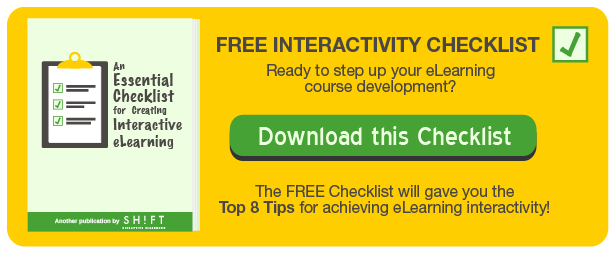 How do you bring the spark back into a boring eLearning course and inject some personality into them? Well, it's all about approaching your course with a little creativity and extra work. Don't worry! In this post you'll learn how to avoid the Boring eLearning Syndrome.
How do you bring the spark back into a boring eLearning course and inject some personality into them? Well, it's all about approaching your course with a little creativity and extra work. Don't worry! In this post you'll learn how to avoid the Boring eLearning Syndrome.
Here are 12 tips and tricks to spice up your eLearning courses the next time your creativity needs a jolt:
Unleash the Power of Templates:
Great authoring tools offer a variety of templates that you can use to create more engaging and meaningful courses. Templates are created to add professionally designed interactivity to your courses without requiring any programming or graphic design skills. Learn more about templates here.
Feature a Main Character:
You can take your courses up a notch with a realistic touch. By using some type of character (avatars,learning agents, real people or even cartoons) you are giving your courses personality and boosting learners’ engagement. You can include them in your scenarios, or while explaining and assessing the learning.
Put Quality Over Quantity:
It can be difficult to eliminate content during eLearning development but it is essential to avoid overwhelming a user. Reducing content is beneficial and can be easily accomplished. Just dumping information and presenting it in the same boring way, actually shuts down the learner’s cognitive processing. So, cut out the unnecessary data. Follow this basic rule: if it doesn't help meet the initial learning objectives, don't include it!
Create podcasts:
Podcasts are a fantastic opportunity to share audio content with your learners. One of the most important educational features offered by podcasting is learning through listening. For many people, listening may be more attractive and less tedious than reading full-text screens.
Try using video:
Words get boring quickly. The perfect way to spice up your boring audience is to include a video. They provide greater engagement than just text or images because they combine audio, video and text. Additionally, it’s an effective way to tell stories, share information and educate. Consider using this resource to share tips, insights or even demonstrate how a product is used.
Use Gamification:
Games definitely make the course more enjoyable to use for the learner. Games represent much more than just points and levels... it's about presenting a challenge, and using interactivity and feedback to achieve specific goals. Just remember, don't focus on entertainment! For further information watch this presentation from Karl Kapp.
Identify your audience and stick with them:
Identify your opportunities, find your audience, and provide them with engaging content. Learn all you can about the learners prior to the course to enable you to design training that meets their needs and fosters their motivation to learn. By doing this, you’ll make a course that is relevant and successful.
Present a Story:
One of our biggest biases is that facts are always superior to emotions, that facts are more reliable and rational. Studies, however, have shown that emotion trumps facts when it comes to our ability to recall. Crafting a story which can capture the imagination of the learner is a great technique to spice up and insert emotion into your courses.
Get active:
Learning is an active pursuit. Ineffective eLearning courses let the learner sit passively, almost encouraging the learner to check out. Provide a learning experience that promotes openness, thought and discussion. Using an active voice rather than the passive voice it’s a good start, but not enough. You can go further by including activities that will make them think and analyze.
Some ways to engage learners actively include:
-
Active buttons in the course to poll learners on their understanding;
-
Student discussion in blogs or communities;
-
Or email to extend the learning past the course parameters.
Offer format variety:
When text fails to get your point across, use other formats such as charts and diagrams, videos, system simulations, infographics, powerful images, etc.
Include links to relevant information:
Hyperlinks are a great (and simple) way to add interactivity to your courses; mainly because they allow learners to click on your screen and jump directly to any additional content they need (a different part of the course, a web page or a document). Hint: Only link to specific pages that are really necessary for the learner to read.
Be practical first… then be cool:
Creating eLearning courses is all about transferring information quickly and efficiently. Avoid the temptation of innovating for the sake of innovation or reinvention. Learners simply want what works and they want you to make it easy for them to find what they want and accomplish what they want to do.
These tips are just for starters. There are plenty of other ways to spice-up your eLearning courses. With a little effort, you can make the learning experience a far more enjoyable one for learners.




